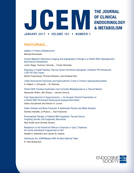-
Views
-
Cite
Cite
JANET A. AMICO, SUE M. CHALLINOR, JUDY L. CAMERON, Pattern of Oxytocin Concentrations in the Plasma and Cerebrospinal Fluid of Lactating Rhesus Monkeys (Macaca mulatto,): Evidence for Functionally Independent Oxytocinergic Pathways in Primates, The Journal of Clinical Endocrinology & Metabolism, Volume 71, Issue 6, 1 December 1990, Pages 1531–1535, https://doi.org/10.1210/jcem-71-6-1531
Close - Share Icon Share
Two populations of oxytocin-staining neurons have been identified in the paraventricular nucleus: magnocellular neurons that terminate in the posterior pituitary and parvocellular neurons that terminate elsewhere in the central nervous system. Whether these oxytocin neurons are functionally separate was tested by measuring oxytocin concentrations in samples of peripheral blood and cerebrospinal fluid (CSF) obtained simultaneously from lactating rhesus monkeys during suckling.
Lactating animals bearing temporary subarachnoid and venous catheters were maintained in a constant photoperiod (0600–1800 h). Samples of CSF were continuously withdrawn by peristaltic pump (0.1 mL/15 min) for 2–4 consecutive days from subarachnoid catheters with the tips placed at the T12–L1 level of the spinal column in four lactating monkeys 4 months postpartum and again after weaning. On 2 of these days, we observed and recorded periods of infant suckling and collected peripheral blood samples (1.2 mL) from the mother at 5-min intervals for 60 min. Oxytocin was measured in blood and CSF by RIA.
Oxytocin concentrations increased in the plasma of the lactating monkeys during periods of nursing, with peak concentrations ranging from 4–16.7 μU/mL. No increase in plasma oxytocin was found on the day after the infant was weaned. Variations in the concentrations of oxytocin in CSF were independent of the suckling stimulus and plasma oxytocin concentrations and occurred during observed periods of no nipple contact by the infant and at the time of weaning after the infant had been removed from the mother. Each lactating animal also displayed a normal circadian variation in CSF oxytocin concentrations, with peak and nadir levels during light and dark hours, respectively.
We conclude that release of oxytocin into the CSF of lactating monkeys is disassociated from release into the peripheral circulation. The data further support the conclusion that neuronal pathways giving rise to oxytocin in the CSF and the periphery are anatomically and functionally separate in primates. (J CUn Endocrinol Metab71: 1531-1535, 1990)





